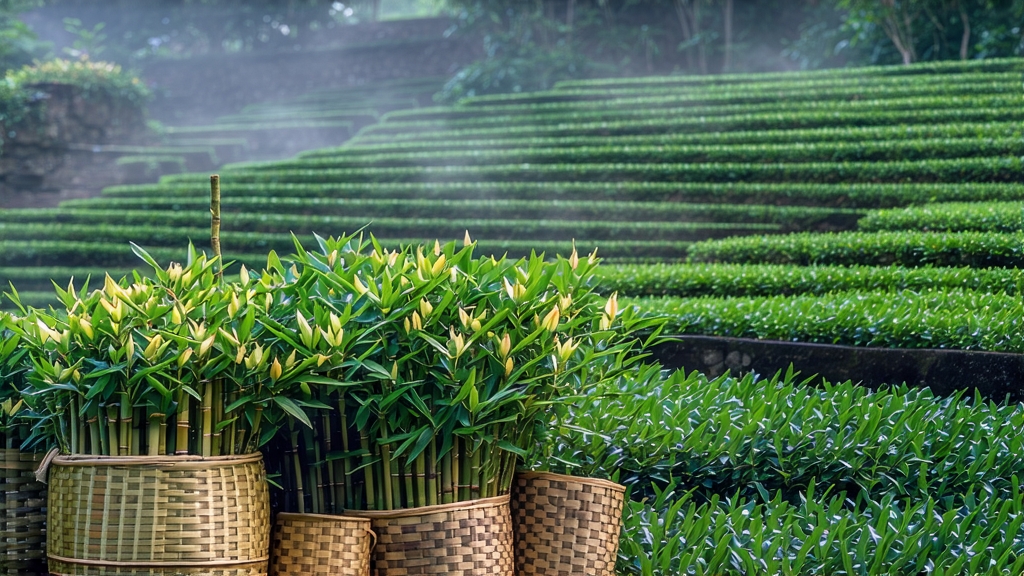
Tucked high on the mist-laden shoulders of Mt. Meng in Sichuan province, Meng Ding Huang Ya—literally “Yellow Bud from the Summit of Meng”—has been whispered about in Chinese tea chronicles since the Tang dynasty (618-907 CE). Court annals from 847 CE record that when Emperor Wuzong fell ill, the governor of Ya Prefecture rushed a cache of these buds to Chang’an; the monarch’s recovery was swift enough that the tea was decreed “imperial tribute” for the next nine centuries. Caravans of porters carried the harvest in bamboo sheaths sealed with camphor leaves, a practice that inadvertently began the micro-fermentation we now call “sealed yellowing,” giving the leaf its signature straw-gold hue and mellowing the astringency that plagues many early-spring greens.
Although Meng Ding Huang Ya is the archetype of yellow tea, three micro-lot styles survive today:
- Ming-qian Jin Zhen (Golden Needle) – plucked on the first three days after Qingming when each bud still wears a single dew-drop; only the unopened spear and half-open leaf are taken.
- Yu-qian Yu Ya (Jade Bud) – picked before the Grain Rain rains arrive; the leaf is marginally larger, yielding a greener liquor and a greener price.
- Gu-hua Lao Huang (Old Yellow after Autumn Flowers) – a late-September harvest that undergoes an extended smother-yellowing, producing a darker, honeyed cup favored by elderly locals for easing late-year humidity.
The craft begins at 4:30 a.m., when mountain temperatures hover at 8 °C, locking in volatile aromatics. Pickers wear cotton gloves to avoid hand-oil contamination; buds drop into shallow bamboo trays lined with hemp cloth to prevent bruising. Within two hours the leaves reach the village workshop, where they are “sha-qing” (kill-green) for exactly 78 seconds in woks held at 160 °C. The decisive step follows: while still at 50 °C the warm leaf is piled 8 cm deep inside square cedar boxes, covered with steamed hemp canvas, and left to suffocate for 40–70 minutes. During this anaerobic interval polyphenols oxidize only at their edges, chlorophyll degrades into pheophytin, and a faint maillard sweetness emerges—think roasted pumpkin married to fresh alfalfa. The leaf is then hand-rubbed along bamboo screens to re-absorb its own moisture, pan-fired a second time at 90 °C to arrest enzymes, and finally dried over a gentle charcoal brazier scented with longan wood. The entire choreography must finish before dusk; any delay and the bud tips turn chestnut, forfeiting the “three yellows” standard—yellow dry leaf, yellow wet leaf, and yellow liquor.
Western tea lovers often confuse yellow tea with lightly oxidized oolong, yet the chemistry diverges. Gas-chromatography studies from the Sichuan Tea Research Institute show Meng Ding Huang Ya carries 3.2 % non-esterified linalool against oolong’s 1.1 %, explaining its honeysuckle top note. Meanwhile the theaflavin-to-thearubigin ratio remains below 0.05, keeping the cup bright instead of russet.
To brew, choose a porcelain gaiwan of 120 ml capacity; the curved walls echo the mountain’s own bowl shape, concentrating aroma. Heat the vessel with 85 °C water, discard, then add 3 g of leaf—about one level tablespoon. The first infusion, 15 seconds at 80 °C, releases a pale jonquil liquor smelling of rain-soaked bamboo shoot. The second, at 20 seconds, delivers the cultivar’s signature “apricot kernel milk” texture, a term local farmers coined because the tea’s amino-rich broth coats the tongue like blanched almond milk. By the fourth steep, lengthened to 45 seconds, a sweet, almost mineral aftertaste lingers, reminiscent of the limestone springs that feed Meng Ding’s terraced gardens.
Professional cupping follows a quieter ritual. Place 5 g in a 250 ml white porcelain taster, infuse for five minutes with freshly drawn water at 85 °C. Evaluate clarity first: top-grade Huang Ya should read 95 % transparent under a 470 nm LED, any cloudiness indicates incomplete yellowing. Next, nose the wet leaf: a faint